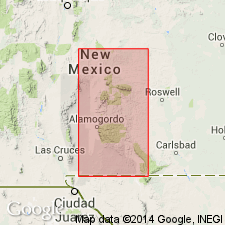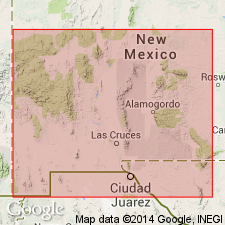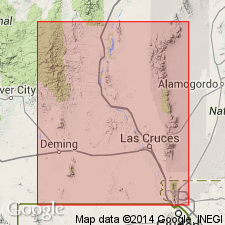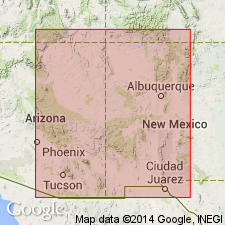
- Usage in publication:
-
- Alamogordo member
- Modifications:
-
- First used
- Dominant lithology:
-
- Siltstone
- Limestone
- Marl
- AAPG geologic province:
-
- Orogrande basin
Summary:
Mississippian formations are underlain by Percha formation of Late Devonian age. Mississippian rocks formerly called Percha removed from Percha and divided into: (ascending): Caballero formation (new) and Lake Valley formation (revised)--itself divided into three units (ascending): Alamogordo, Arcente, and Dona Ana members (all new). Alamogordo consists normally of 4 distinct facies: a siltstone at base, overlain by hard, black cherty limestone, overlain by soft, blue-gray marl, and capped by gray, thin-bedded crinoidal limestone. Some large crinoidal bioherms; bioherm facies consists of rounded dome-shaped masses of black, relatively nonfossiliferous, almost featureless limestone. 130 ft thick at type. Overlies Kinderhookian Caballero formation unconformably. A large amount of reworked Caballero sediments is usually found in basal Lake Valley [Alamogordo]. The Mississippian beds in Sacramento Mountains area are better developed than in Lake Valley area at Lake Valley, Sierra Co, Orogrande basin. Caballero formation is present in both areas, but Lake Valley beds at Lake Valley are all correlated with Alamogordo member as developed in Sacramento Mountains. Arcente and Dona Ana members not present at Lake Valley. Is Osage (Mississippian) age.
Source: GNU records (USGS DDS-6; Denver GNULEX).
- Usage in publication:
-
- Alamogordo member
- Modifications:
-
- [Principal reference]
- Dominant lithology:
-
- Limestone
- Marl
- Chert
- AAPG geologic province:
-
- Orogrande basin
Laudon, L.R., and Bowsher, A.L., 1941, Mississippian formations of Sacramento Mountains, New Mexico: American Association of Petroleum Geologists Bulletin, v. 25, no. 12, p. 2107-2160.
Summary:
Pg. 2114-2116, 2118-2119 (figs. 5, 6), 2125-2133; Laudon and Bowsher [abs.], 1941, Tulsa Geol. Soc. Digest, v. 9, p. 73, 74 (strat. column). Alamogordo member of Lake Valley formation. Defined as basal member of Lake Valley formation. Consists normally of four distinct facies (ascending): (1) basal siltstone containing reworked sediments from underlying Caballero Formation (new); (2) hard cherty limestone; (3) soft blue-gray marl; and (4) gray thin-bedded crinoidal limestone at top. Member is complicated by large crinoidal bioherms; bioherm facies consists of rounded dome-shaped masses of black relatively unfossiliferous almost featureless limestone. Thickness 130 feet. Underlies Arcente member (new) of Lake Valley formation; unconformably overlies Caballero formation. Is a distinct cliff-former. Fossils; carries Osage fauna (ZAPHRENTIS CLIFFORDANA, RHIPIDOMELLA MISSOURIENSIS, DICTYOCLOSTUS FERNGLENSIS, ATHYRIS LAMELLOSA, CLIOTHYRIDINA GLENPARKENSIS, PTYCHOSPIRA SEXPLICATA). Age is Mississippian (Osage).
[Type area]: in Deadman Canyon, near Alamogordo, in sec. 3, T. 17 S., R. 10 E., Otero Co., southern NM.
Source: Publication; US geologic names lexicon (USGS Bull. 1200, p. 36).

- Usage in publication:
-
- Alamogordo member
- Modifications:
-
- Revised
- Areal extent
- AAPG geologic province:
-
- Orogrande basin
- Pedregosa basin
- Basin-and-Range province
Summary:
Alamogordo member of Lake Valley formation revised in report area, southwestern NM. Alamogordo as originally defined by Laudon, Bowsher (1941) included the beds designated in this report as (ascending) Andrecito, Alamogordo, Nunn, and Tierra Blanca (all but Alamogordo are new names, this report). Name Alamogordo is here restricted to the massive, black, very cherty, poorly fossiliferous, cliff-forming limestone beds above the thin-bedded Andrecito member and below the soft, blue-gray, crinoidal marls of Nunn member. Alamogordo (restricted) makes a continuous scarp along front of the Sacramento Mountains, Otero Co, and is the most widely distributed member of Lake Valley formation. Areal extent is Orogrande and Pedregosa basins and Basin-and-Range province. Thickness averages from 30-50 ft and is fairly constant. Variation in thickness occurs particularly where bioherms are developed. Alamogordo forms the base from which the central biohermal structures rise. In many places it is part of the central biohermal structure. Is thinnest in Cook Mountains, Luna Co. Not exposed in Hueco and Franklin Mountains, TX, in southernmost Orogrande basin. Is Osage (Mississippian) in age. Measured sections, cross sections, areal extent maps.
Source: GNU records (USGS DDS-6; Denver GNULEX).

- Usage in publication:
-
- Alamogordo member
- Modifications:
-
- Areal extent
- AAPG geologic province:
-
- Orogrande basin
Summary:
Pg. 74 (fig. 9), 83, 84 (fig. 10). Alamogordo member of Lake Valley formation. Geographically extended into Caballo Mountains area, Sierra County, southern New Mexico, where it is shown as overlying Percha shale. Age is Mississippian (Osage).
Source: US geologic names lexicon (USGS Bull. 1200, p. 36).

- Usage in publication:
-
- Alamogordo Member*
- Modifications:
-
- Biostratigraphic dating
- AAPG geologic province:
-
- Basin-and-Range province
- Orogrande basin
Summary:
Is a member of Lake Valley Limestone in southwest NM. Columnar sections at Bear Mountain, Grant Co, and in North Cooks Range, Luna Co (both in southeastern Basin-and-Range province) and at Lake Valley, Sierra Co (western Orogrande basin). Overlies Andrecito Member of Lake Valley at all three sections. Underlies Nunn Member of Lake Valley at Lake Valley and North Cooks Range; underlies Tierra Blanca Member of Lake Valley at Bear Mountain where Nunn Member is absent, apparently due to facies change. Biostratigraphic dating with foraminifers yields zone pre-7 (Kinderhookian, Lower Mississippian) at Lake Valley section, and upper part is zone 7? (Kinderhookian) at Bear Mountain. Regional correlations on fig. 2; is correlated with lower part of Witch Member of Keating Formation in Escabrosa Group in Pedregosa basin. Kinderhookian-Osagean provincial series boundary questionably placed at upper contact of Alamogordo. Age is Kinderhookian (Early Mississippian).
Source: GNU records (USGS DDS-6; Denver GNULEX).
For more information, please contact Nancy Stamm, Geologic Names Committee Secretary.
Asterisk (*) indicates published by U.S. Geological Survey authors.
"No current usage" (†) implies that a name has been abandoned or has fallen into disuse. Former usage and, if known, replacement name given in parentheses ( ).
Slash (/) indicates name conflicts with nomenclatural guidelines (CSN, 1933; ACSN, 1961, 1970; NACSN, 1983, 2005, 2021). May be explained within brackets ([ ]).

